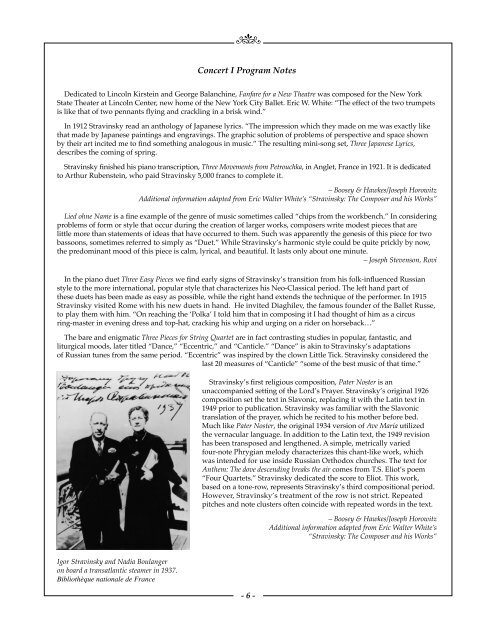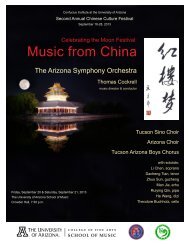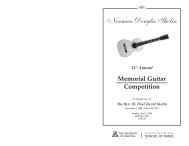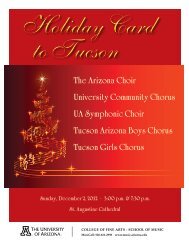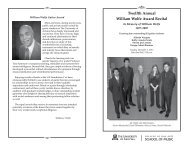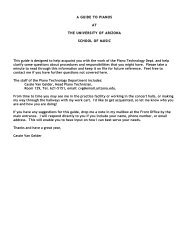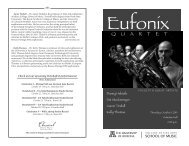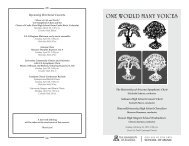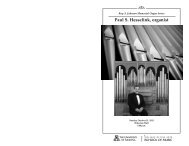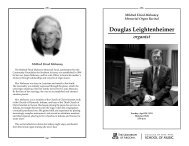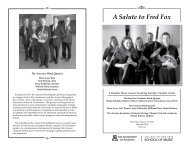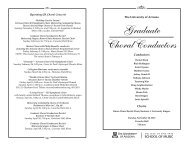Download Event Program - School of Music - University of Arizona
Download Event Program - School of Music - University of Arizona
Download Event Program - School of Music - University of Arizona
Create successful ePaper yourself
Turn your PDF publications into a flip-book with our unique Google optimized e-Paper software.
nConcert I <strong>Program</strong> NotesDedicated to Lincoln Kirstein and George Balanchine, Fanfare for a New Theatre was composed for the New YorkState Theater at Lincoln Center, new home <strong>of</strong> the New York City Ballet. Eric W. White: “The effect <strong>of</strong> the two trumpetsis like that <strong>of</strong> two pennants flying and crackling in a brisk wind.”In 1912 Stravinsky read an anthology <strong>of</strong> Japanese lyrics. “The impression which they made on me was exactly likethat made by Japanese paintings and engravings. The graphic solution <strong>of</strong> problems <strong>of</strong> perspective and space shownby their art incited me to find something analogous in music.” The resulting mini-song set, Three Japanese Lyrics,describes the coming <strong>of</strong> spring.Stravinsky finished his piano transcription, Three Movements from Petrouchka, in Anglet, France in 1921. It is dedicatedto Arthur Rubenstein, who paid Stravinsky 5,000 francs to complete it.– Boosey & Hawkes/Joseph HorowitzAdditional information adapted from Eric Walter White’s “Stravinsky: The Composer and his Works”Lied ohne Name is a fine example <strong>of</strong> the genre <strong>of</strong> music sometimes called “chips from the workbench.” In consideringproblems <strong>of</strong> form or style that occur during the creation <strong>of</strong> larger works, composers write modest pieces that arelittle more than statements <strong>of</strong> ideas that have occurred to them. Such was apparently the genesis <strong>of</strong> this piece for twobassoons, sometimes referred to simply as “Duet.” While Stravinsky’s harmonic style could be quite prickly by now,the predominant mood <strong>of</strong> this piece is calm, lyrical, and beautiful. It lasts only about one minute.– Joseph Stevenson, RoviIn the piano duet Three Easy Pieces we find early signs <strong>of</strong> Stravinsky’s transition from his folk-influenced Russianstyle to the more international, popular style that characterizes his Neo-Classical period. The left hand part <strong>of</strong>these duets has been made as easy as possible, while the right hand extends the technique <strong>of</strong> the performer. In 1915Stravinsky visited Rome with his new duets in hand. He invited Diaghilev, the famous founder <strong>of</strong> the Ballet Russe,to play them with him. “On reaching the ‘Polka’ I told him that in composing it I had thought <strong>of</strong> him as a circusring-master in evening dress and top-hat, cracking his whip and urging on a rider on horseback…”The bare and enigmatic Three Pieces for String Quartet are in fact contrasting studies in popular, fantastic, andliturgical moods, later titled “Dance,” “Eccentric,” and “Canticle.” “Dance” is akin to Stravinsky’s adaptations<strong>of</strong> Russian tunes from the same period. “Eccentric” was inspired by the clown Little Tick. Stravinsky considered thelast 20 measures <strong>of</strong> “Canticle” “some <strong>of</strong> the best music <strong>of</strong> that time.”Stravinsky’s first religious composition, Pater Noster is anunaccompanied setting <strong>of</strong> the Lord’s Prayer. Stravinsky’s original 1926composition set the text in Slavonic, replacing it with the Latin text in1949 prior to publication. Stravinsky was familiar with the Slavonictranslation <strong>of</strong> the prayer, which he recited to his mother before bed.Much like Pater Noster, the original 1934 version <strong>of</strong> Ave Maria utilizedthe vernacular language. In addition to the Latin text, the 1949 revisionhas been transposed and lengthened. A simple, metrically variedfour-note Phrygian melody characterizes this chant-like work, whichwas intended for use inside Russian Orthodox churches. The text forAnthem: The dove descending breaks the air comes from T.S. Eliot’s poem“Four Quartets.” Stravinsky dedicated the score to Eliot. This work,based on a tone-row, represents Stravinsky’s third compositional period.However, Stravinsky’s treatment <strong>of</strong> the row is not strict. Repeatedpitches and note clusters <strong>of</strong>ten coincide with repeated words in the text.– Boosey & Hawkes/Joseph HorowitzAdditional information adapted from Eric Walter White’s“Stravinsky: The Composer and his Works”Igor Stravinsky and Nadia Boulangeron board a transatlantic steamer in 1937.Bibliothèque nationale de France- 6 -


